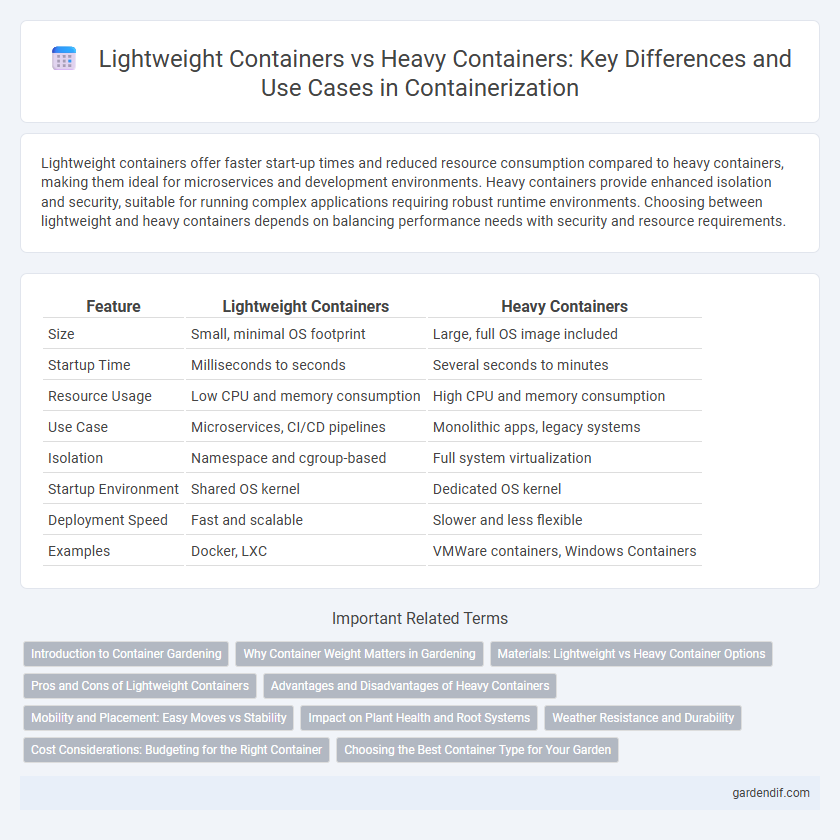
Lightweight containers vs heavy containers Illustration
Lightweight containers offer faster start-up times and reduced resource consumption compared to heavy containers, making them ideal for microservices and development environments. Heavy containers provide enhanced isolation and security, suitable for running complex applications requiring robust runtime environments. Choosing between lightweight and heavy containers depends on balancing performance needs with security and resource requirements.
Table of Comparison
| Feature | Lightweight Containers | Heavy Containers |
|---|---|---|
| Size | Small, minimal OS footprint | Large, full OS image included |
| Startup Time | Milliseconds to seconds | Several seconds to minutes |
| Resource Usage | Low CPU and memory consumption | High CPU and memory consumption |
| Use Case | Microservices, CI/CD pipelines | Monolithic apps, legacy systems |
| Isolation | Namespace and cgroup-based | Full system virtualization |
| Startup Environment | Shared OS kernel | Dedicated OS kernel |
| Deployment Speed | Fast and scalable | Slower and less flexible |
| Examples | Docker, LXC | VMWare containers, Windows Containers |
Introduction to Container Gardening
Lightweight containers for gardening offer portability and ease of movement, making them ideal for small spaces and beginner gardeners. Heavy containers, often made from materials like ceramic or concrete, provide stability and better insulation for plant roots in varying weather conditions. Selecting the right container depends on factors such as plant type, location, and desired mobility in container gardening.
Why Container Weight Matters in Gardening
Container weight significantly impacts gardening by influencing mobility, ease of placement, and plant health. Lightweight containers, often made from materials like plastic or fiberglass, allow gardeners to reposition plants quickly to optimize sunlight exposure or protect them from harsh weather. Heavy containers, typically constructed from ceramic or concrete, provide stability in windy conditions but may limit flexibility and increase physical strain during garden maintenance.
Materials: Lightweight vs Heavy Container Options
Lightweight containers are typically made from materials like aluminum, polyethylene, or high-density polypropylene, offering durability with reduced weight for easier transportation. Heavy containers often use steel or reinforced fiberglass, providing superior strength and impact resistance suited for industrial or hazardous materials storage. Selecting the appropriate material balances portability and robustness based on specific application requirements.
Pros and Cons of Lightweight Containers
Lightweight containers offer faster startup times and reduced resource consumption compared to heavy containers, making them ideal for microservices and scalable applications. Their minimal overhead enhances efficiency and simplifies deployment but can limit support for complex or stateful applications requiring extensive dependencies. Choosing lightweight containers improves agility and resource utilization, though it may necessitate additional configuration to handle more intricate workloads.
Advantages and Disadvantages of Heavy Containers
Heavy containers offer superior durability and enhanced protection for goods during long-distance shipping, making them ideal for transporting hazardous or valuable materials. The increased sturdiness often results in higher upfront costs and greater transportation fuel consumption due to added weight. Despite these disadvantages, heavy containers provide better security and resistance to environmental stress, reducing damage risks and loss in demanding shipping environments.
Mobility and Placement: Easy Moves vs Stability
Lightweight containers offer superior mobility with faster deployment and ease of transfer across diverse environments, making them ideal for dynamic workloads and frequent relocation. Heavy containers provide enhanced stability and robustness, suitable for long-term placement in fixed infrastructures where performance consistency is critical. Choosing between lightweight and heavy containers depends on balancing portability needs against operational durability for optimal placement strategy.
Impact on Plant Health and Root Systems
Lightweight containers promote better aeration and drainage, reducing root rot and encouraging robust root development, which enhances overall plant health. Heavy containers often retain excess moisture, increasing the risk of fungal diseases and limiting oxygen availability to roots. Optimal container choice directly influences root system vitality and plant growth efficiency.
Weather Resistance and Durability
Lightweight containers are designed with materials such as reinforced plastics and aluminum alloys that offer moderate weather resistance and durability, making them suitable for short-term outdoor storage and transport. Heavy containers, often constructed from steel or composite metals, provide superior protection against harsh weather conditions, corrosion, and mechanical impact, ensuring long-term durability and secure containment. Choosing between lightweight and heavy containers depends on specific needs for exposure resistance and structural longevity in varying environmental conditions.
Cost Considerations: Budgeting for the Right Container
Lightweight containers significantly reduce infrastructure costs by requiring less memory and CPU resources compared to heavy containers, making them ideal for cost-sensitive projects. Heavy containers, while more resource-intensive, provide robust performance and isolation but demand higher cloud service and hardware expenses. Budgeting for container deployment should balance resource needs and cost efficiency, prioritizing lightweight containers for scalable, affordable solutions.
Choosing the Best Container Type for Your Garden
Lightweight containers, often made from materials like plastic or fiberglass, offer easy mobility and quick drainage, making them ideal for balcony or small garden spaces. Heavy containers made from ceramic, concrete, or stone provide superior stability and insulation, protecting roots from temperature fluctuations and strong winds in larger garden setups. Selecting the best container type depends on factors such as plant species, garden size, climate, and whether portability or durability is a priority.
Lightweight containers vs heavy containers Infographic

 gardendif.com
gardendif.com